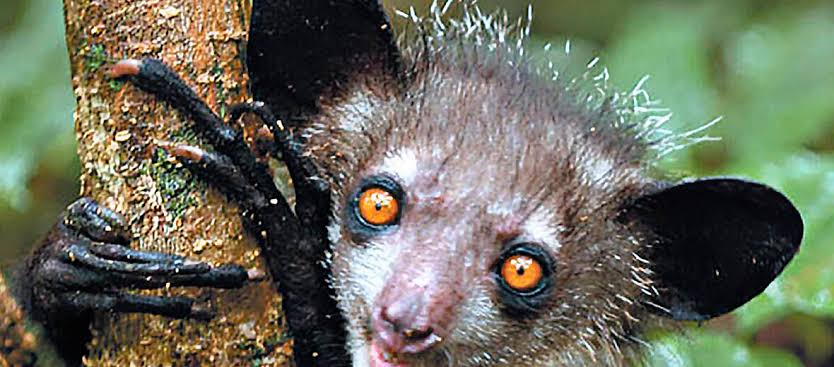In the dense forests of Madagascar, the eerie silhouette of the aye-aye lurks among the shadows, its large eyes scanning the darkness for signs of life. As the world’s largest nocturnal primate, the aye-aye has evolved unique hunting and defensive strategies to survive in its complex environment.
Hunting for the aye-aye is not a simple task; it requires patience, precision, and a keen sense of hearing. With its specialized elongated middle finger, the aye-aye taps on trees, listening intently for the hollow sound that indicates the presence of grubs or insects beneath the bark. Once it detects a potential meal, the aye-aye gnaws through the wood using its powerful incisors, revealing the hidden treasure within.
As the aye-aye extracts its meal with its slender, nimble fingers, it showcases its remarkable adaptation for extracting food from hard-to-reach places. Its elongated third digit, which is much longer than the others, acts as a precise tool for scooping out grubs and insects from their wooden hideouts. This unique hunting method allows the aye-aye to access a food source that is often overlooked by other animals, giving it a competitive edge in the forest ecosystem.
However, the aye-aye’s hunting prowess is not without its challenges. Despite its remarkable adaptations, finding food in the dense forest can be a daunting task, especially when competing with other nocturnal hunters such as owls and fossas. To increase its chances of success, the aye-aye relies on its acute sense of smell and hearing to detect the faintest rustle of prey amidst the cacophony of forest sounds.
In addition to hunting, the aye-aye must also protect itself from potential threats in its environment. Despite its fearsome appearance, the aye-aye is actually a timid and solitary creature, preferring to avoid confrontations whenever possible. When faced with danger, such as the presence of a predator, the aye-aye relies on its agility and agility to evade capture.
One of the aye-aye’s most effective defensive strategies is its ability to camouflage itself within the dense foliage of the forest canopy. With its dark fur and large, expressive eyes, the aye-aye blends seamlessly into its surroundings, making it difficult for predators to spot. In addition, the aye-aye is capable of moving quickly and silently through the treetops, allowing it to escape danger before it even has a chance to strike.
Despite its best efforts to avoid conflict, there are times when the aye-aye must defend itself against predators. In these situations, the aye-aye relies on its sharp claws and powerful jaws to fend off attackers. While it may not be as physically imposing as other animals in the forest, the aye-aye’s agility and resourcefulness make it a formidable opponent when cornered.
In addition to physical defenses, the aye-aye also employs a range of vocalizations to communicate with other members of its species and deter potential threats. From high-pitched shrieks to low growls, the aye-aye uses its vocal repertoire to assert its dominance and warn others of impending danger.
Overall, the aye-aye’s hunting and defensive strategies are a testament to the remarkable adaptability of this unique primate. Through a combination of specialized anatomical features, keen senses, and clever tactics, the aye-aye has carved out a niche for itself in the challenging environment of the Madagascar rainforest. As long as it continues to evolve and adapt to changing conditions, the aye-aye will remain a fascinating and enigmatic inhabitant of the island’s rich biodiversity.


